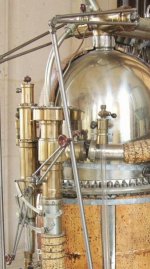My guess is some sort of light-weight "expansion engine", possibly for an early aircraft (semi-rigid balloon with engine driven propellor ?). Alberto Santos-Dumont had circled the Eifel Tower in an early "airship" consisting of a sausage shaped "gas bag" with tail stabilizer, rudder, and possibly elevator fins. Propulsion was done with a large propellor turned by some kind of engine. Given the early date of this flight, I would not be surprised if it were some kind of "expansion engine" (using something like the expansion of carbon dioxide or compressed air) rather than steam.
An expansion engine of that time period would be built similar to a steam engine. The gas used, such as compressed air or carbon dioxide, would need to be stored in a high-pressure "flask". The expansion of the gas would drop its temperature quite a bit, possibly with a freeze-up occurring in the engine cylinders. Hence, there is that "radiator" to warm the gas to closer to ambient temperature before it enters the engine. If carbon dioxide was used, this would account for the cork insulation on the storage tank (aka "flask" or "bottle").
The high degree of finish on the parts all points to someone with plenty of money to spend on this "machine" and wanting to "showcase" it. Something like early manned flight would be the kind of thing that this sort of high degree of finish on the engine and its related parts would demand. I am likely way off course in thinking this engine has anything to with Santos-Dumont, but he is the only early pioneer of manned flight in France that I can think of. Santos-Dumont was something of a showman and wealthy enough (or had wealthy backers for his experiments) to spare no expense in having this engine and its related parts built to this high degree of finish.
I am pipe-dreaming (pardon the pun) about Santos-Dumont or other early experimenters and their early lighter-than-air aircraft in terms of this engine, but a long forgotten line of thinking did fly (again, pardon the pun) into my mind. With that line of thinking comes the recollection of the old "Mad Magazine" of the 60's. In the old "Mad Magazine", there were the usual satirical cartoons and similar, but often, a small drawing of the "Mad Zeppelin"- a semi rigid gas-bag with a gondola having a vertical boiler and steam engine to turn the prop comes to mind.
The other name that comes to mind is a German experimenter named Lilienthal. Lilienthal was experimenting with what, today would be known as "hang gliders". His research and data was used by the Wright Brothers, if I am not mistaken. Lilienthal was jumping from steep hillsides or cliffs with his gliders and was getting further in his flights. The next step was powered flight. Lilienthal attempted to use some kind of expansion engine (pressurized tank of carbon dioxide or compressed air to drive it). Unfortunately for Lilienthal, on his first attempt at powered flight, he crashed and was killed. Some accounts say that Lilienthal did not realize something all airplane and helicopter pilots are well aware of: the "Coriolus Effect" or "P factor"- the tendency of an aircraft to twist with the torque applied to the prop.
Lilienthal apparently jumped off a cliff with his powered hang glider and opened the throttle to the engine. The resulting reaction to the torque of the prop caused his aircraft to go into a violent and uncontrollable condition (wing-over stall ?) and Lilienthal and his craft crashed to the ground. It was the end of Herr Lilienthal. I used to wonder that, had Lilienthal been successful with his powered hang glider, if he would have pre-dated the Wright Brothers.
The only other name for early manned flight that comes to mind is Samuel Langley. Langley had the backing of the Smithsonian Institute. He was experimenting with a huge heavier-than-air "contraption" which he called the "aerodrome". It was supposedly "steam powered" and was launched by catapult from a barge in the Potomac River. I think it crashed into the river as soon as it was launched off the barge. Langley had the wealthy backers to have a finely finished "expansion engine" as shown in this thread built. What the press and written accounts call a "steam engine" may well have been an expansion engine. Using Carbon dioxide gas or some combination of substances that combined and reacted to produce steam (such as were used in torpedoes) may well have been what this engine ran on. The exhaust, leaving a cloud of white gas, was probably mistaken for steam.
So, my two guesses are: either a very early lighter than air aircraft (ala Santos Dumont or similar), or Samuel Langley and his "aerodrome"'s expansion engine.
 1.
1.  2.
2.  3.
3.  4.
4.







